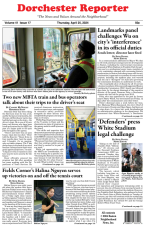May 2, 2022

Federal investigators said Monday that a door safety system failed on a Red Line train (pictured), allowing the train to depart Broadway Station on April 10 while passenger Robinson Lalin was trapped in the door. Lalin died as a result of the accident. [NTSB]
A Red Line train's door safety system failed when a passenger became trapped in a fatal accident last month, federal investigators announced Monday.
In its preliminary investigation report, the National Transportation Safety Board said the rider -- whom the T previously identified as Robinson Lalin -- was attempting to exit a Red Line train at Broadway Station around 12:30 a.m. on April 10 when his right arm got caught in a closing door.
MBTA trains are designed not to move when any passenger door is obstructed, but when NTSB investigators examined the car where Lalin became trapped, they found a "fault in a local door control system that enabled the train to move with the door obstructed." The train departed Broadway, fatally dragging Lalin more than 100 feet along the platform and the ground near the tracks, NTSB said.
"The MBTA immediately initiated a fleet inspection looking for the identified fault in other railcars to prevent reoccurrence," NTSB wrote in its report. "The MBTA reported that no other similar faults were found during the inspection."
A T spokesperson said the federal agency's findings "confirmed the MBTA's initial assessment of a short circuit in the car's wiring that allowed the train to begin moving while Mr. Lalin was attempting to exit through the closing doors."
"Immediately following the accident, the door systems throughout out (sic) the Red Line fleet were tested for this specific problem, and MBTA personnel found all components performed as designed and did not identify any additional instances of the circuitry problem the incident car experienced," the spokesperson said in a statement. "During rigorous testing, the problem with the incident car could not be duplicated in any of the other Red Line cars of the same make and model."
The train car involved in the accident was part of the "Type 1" series, which started running in 1969 and 1970 and were rebuilt between 1985 and 1988, according to a spokesperson. The current Red Line fleet has 70 other Type 1 cars.
The T is in the midst of a years-long project to replace the entire Red and Orange Line fleets with new vehicles. Some new trains for both lines are already in service, and after a previous delay, the MBTA now expects delivery of the final Orange Line cars by April 2023 and the final Red Line cars by September 2024.
NTSB officials said the agency's investigation is ongoing and will focus on "the MBTA's passenger train equipment and operating procedures."
Workers at the T will also perform additional tests on top of "existing door inspection protocols," the T said.
In 2019, an independent panel concluded that "safety is not the priority at the T" after a months-long review. Its members cited fiscal belt-tightening, insufficient maintenance staff and a lack of trust in leadership as key factors.
Since that report, the MBTA has hired hundreds of additional safety-related workers and continued a Baker-era trend of increasing annual capital spending, though the agency continues to face major operating budget pressure and expects a shortfall of hundreds of millions of dollars to hit next year.


